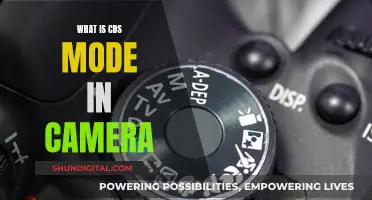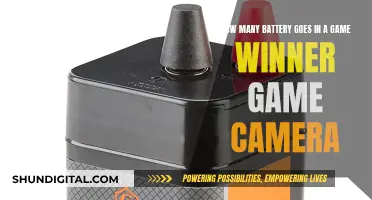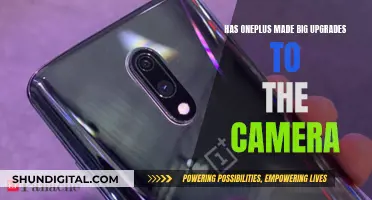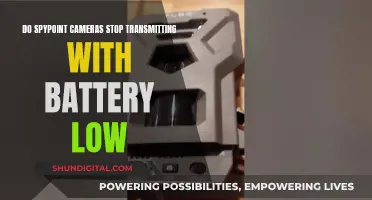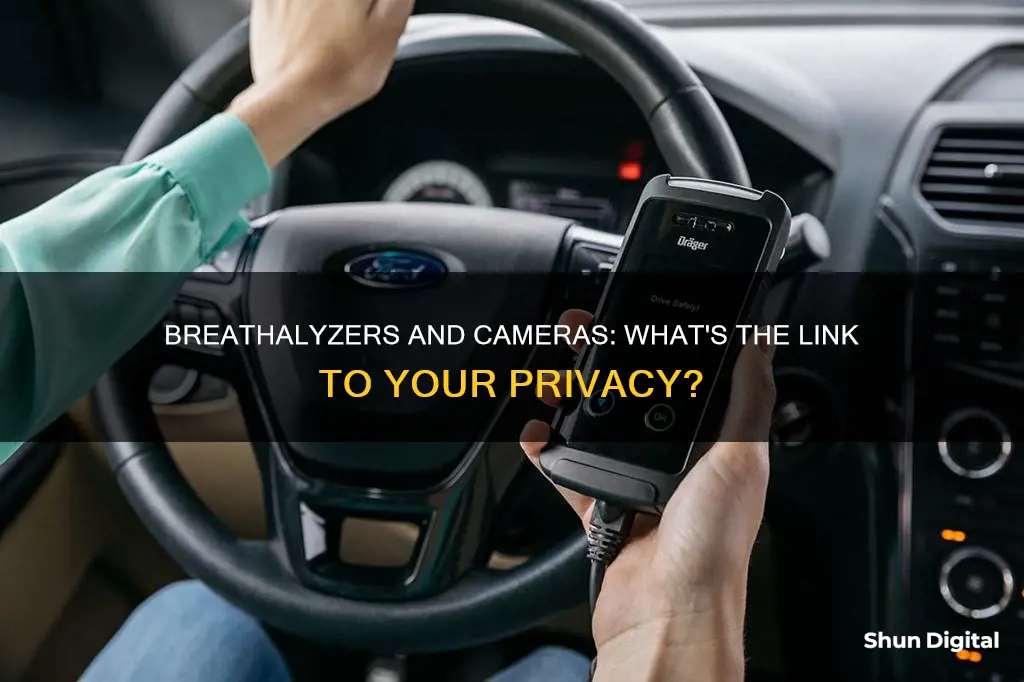
Car breathalyzers, also known as ignition interlock devices, are often installed in vehicles to prevent drunk driving. These devices work by requiring a breath sample before allowing the engine to ignite. To prevent circumvention, some states and counties require the addition of a camera to the breathalyzer. The camera takes a photo of the person providing the breath sample to ensure that the driver is the one being tested. This measure helps uphold legal obligations and prevents intoxicated individuals from endangering others by driving. While the camera does not record video, it captures photos during the initial test and random retests, providing evidence of the driver's identity and sobriety.
| Characteristics | Values |
|---|---|
| Purpose | To document the identity of the person using the breathalyzer and prevent cheating |
| Installation | Mounted on the windshield of any vehicle |
| Functionality | Captures images of the person taking the test and during random retests |
| Data Privacy | Images are stored securely and shared only with authorized personnel |
| Compliance | Required in some states as mandated by state or local jurisdiction |
What You'll Learn

Cameras prevent cheating
Ignition Interlock Devices (IIDs), also known as car breathalyzers, are often required for individuals who have been arrested or convicted of drunk driving offences. These devices work by requiring a breath sample before allowing the engine to ignite. If the sample is above the legal limit, the engine will not start.
However, some people have found ways to cheat the system, such as by having a sober friend blow into the device. To prevent this, many states now require IIDs to be equipped with cameras. The camera snaps a photo of the person providing the breath sample, ensuring that the correct person is being tested. This helps to prevent cheating and false accusations, and enhances accountability.
The use of cameras with IIDs is not a standard requirement across all states. It depends on the specific state, county, or judge assigned to the case. Currently, Washington and Virginia are the only two states that automatically require an IID with a camera. In other states, a camera may be ordered by a judge but is not typically necessary.
It is important to note that the camera on an IID is not capable of recording video. It simply snaps a photo when a breath sample is provided. These photos are kept strictly confidential and are only reviewed by a small number of staff from the interlock provider. They are used solely for confirming the identity of the person providing the breath sample.
By implementing cameras with IIDs, states can better ensure that individuals are adhering to the rules and staying alcohol-free while on the road. This not only fosters personal growth and rehabilitation but also enhances road safety for everyone.
Focus Faster: Quick Camera Tricks for Sharp Photos
You may want to see also

Cameras don't record
Ignition interlock devices (also known as car breathalyzers) are often installed in vehicles following a drunk driving conviction. These devices combine a breathalyzer and an immobilizer, and are hooked up to a vehicle's engine ignitor. If a person wishes to drive, they must provide a breath sample by blowing into the device. The device then measures the blood alcohol content percentage in the breath sample. If the sample is below the legal limit, the engine will ignite. If the sample is above the threshold, the engine will be inhibited.
Some ignition interlock devices are also equipped with cameras. These are used to snap a photo of the person providing the breath sample, ensuring that the correct person is being tested. The camera does not record video, nor does it take photos at any time other than during the initial test and any subsequent retests. Photos are kept strictly confidential and are only reviewed by a small number of members of staff at the interlock provider. They are not held by the state, uploaded to a public database, or discoverable under public records requests.
Mastering Manual Focus on Your Galaxy J7 Camera
You may want to see also

Photos are confidential
Photos taken by car breathalyzers are strictly confidential. They are not leaked to the internet or shared on social media. Only one or two members of the interlock provider's staff review the photos to confirm that the person providing the breath sample is the driver. These photos are not held by the state, uploaded to a public database, or discoverable under public records requests.
Interlock providers are aware that their devices are invasive, so they do not record video or turn your drive into a live stream. The camera only snaps a photo when a person provides a breath sample. This includes the initial test and a rolling retest. The photos are taken to prevent cheating, such as having a sober friend blow into the device.
The photos are stored, captured, and supplied to monitoring authorities as needed, depending on the state's ignition interlock program requirements. At the regular monitoring and calibration appointment, the photos are downloaded with the other ignition interlock data. If no irregularities are spotted, all is well.
Companies like LifeSafer Ignition Interlock take data privacy very seriously. They have redundant data security protocols in place to ensure that all information is encrypted and only shared with authorized personnel.
Charging Your JVC GR-D850U Camera: Alternative Methods
You may want to see also

Cameras enhance accountability
The use of camera units on ignition interlock devices has grown nationwide and is now a common requirement for ignition interlock device programs. The camera verifies the driver is the one providing the breath sample. If others in the household use the vehicle, the camera can provide evidence that the customer was not the person giving the sample or attempting to drive in violation of their requirements. It is important to note that all violations are still recorded, regardless of who was driving at the time.
The camera on an interlock device is not capable of recording video; it merely snaps a photo any time a person provides a breath sample. Interlock providers are aware that their devices are invasive enough without turning your drive into a live stream. The only times a photo will be taken are during the initial test and then during a rolling retest.
The pictures snapped by the device are kept strictly confidential and are only reviewed by one or two members of the interlock provider’s staff. Workers who evaluate the photos are just seeking to confirm that you are the person who was actually providing the breath sample. To ensure your privacy, the photos are not held by the state, uploaded to a public database, or discoverable under public records requests.
Having a camera on your interlock device can help prevent false accusations and incorrect ignition interlock device violations. For example, if a friend, relative, or spouse drove your car, they might drive with a blood alcohol concentration of .05. While that is beneath the legal limit for them, it would be a violation for you. Having a camera provides evidence that you were not the driver responsible for that breath sample.
Ignition Interlock cameras, first and foremost, enhance accountability. They ensure that the driver adheres to the rules and stays alcohol-free while on the road, fostering personal growth and rehabilitation. Moreover, Ignition Interlock cameras act as a formidable deterrent against drunk driving. Knowing that your actions are under constant surveillance is often enough to discourage individuals from driving under the influence.
Charging the Digi Cool Camera: A Quick Guide
You may want to see also

Cameras are easy to use
For instance, the Canon EOS R10 combines a simple touchscreen interface with an effective autofocus system. Its DSLR-style controls and ability to capture 4K video and HDR footage make it a great choice for those seeking an easy-to-use camera. Similarly, the Olympus PEN E-PM2 features on-screen guides that explain each setting in simple language, making it more accessible for novice photographers.
Easy-to-use cameras are also available in the form of point-and-shoot options. These compact cameras offer automatic operation and are perfect for capturing moments on the go. The Canon PowerShot Elph 330 HS, for instance, is a sleek and affordable choice that allows for instant image sharing via Wi-Fi.
Additionally, some cameras cater to specific needs, such as the KODAK PIXPRO WPZ2, a waterproof and shockproof camera ideal for outdoor adventures. Or the Canon EOS Rebel SL1, a high-performing yet tiny DSLR that fits comfortably in your hands.
Ultimately, modern cameras offer a range of user-friendly features, making photography more accessible and enjoyable for beginners and enthusiasts alike. With intuitive interfaces, automatic functions, and innovative technologies, capturing memorable moments has never been easier.
Charging the HP R847: A Step-by-Step Guide
You may want to see also
Frequently asked questions
Yes, car breathalyzers can have cameras, but whether or not a camera is installed depends on the state, county, or judge's requirements.
The camera is used to verify the identity of the person providing the breath sample and ensure that the driver is adhering to the rules and staying alcohol-free.
The camera only takes pictures at designated times, typically when the user is powering up the device, taking the test, and starting the vehicle. It may also take pictures during random retests after the vehicle has been started.
The pictures are kept strictly confidential and are only reviewed by one or two members of the interlock provider's staff to confirm the identity of the person providing the breath sample. They are not held by the state, uploaded to a public database, or discoverable under public records requests.
No, blocking, moving, or tampering with the camera in any way is considered a violation and may result in penalties.


